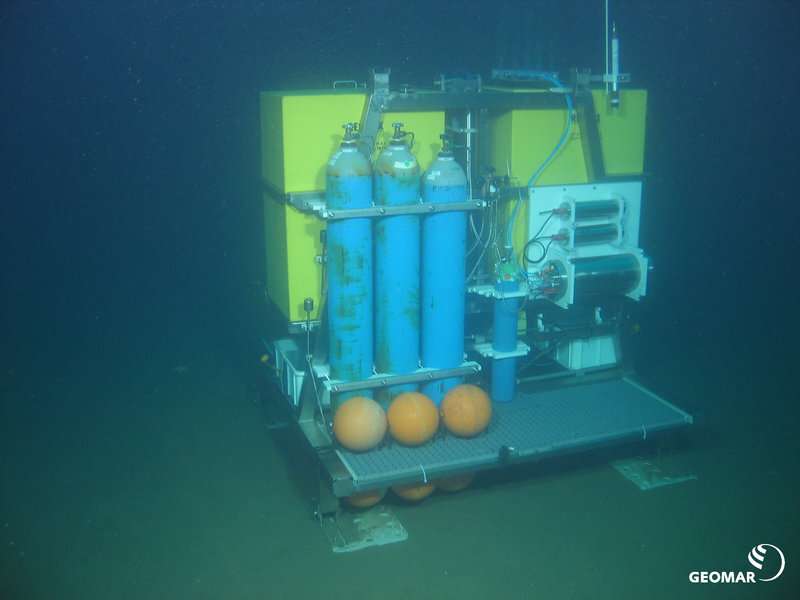Picture showing the setup of the gas release experiment with the Ocean Elevator lander (with yellow syntactic foam blocks) and mounted equipment (CO2 and Krypton gas bottles, battery packs, control unit and gas release head) deployed at ~80 m water depth in the vicinity of the Sleipner CO2 storage site. Credit: ROV-Team/GEOMAR.
Realistic estimates show that global warming can only be kept below 1.5 or two degrees Celsius if carbon dioxide is actively removed from the atmosphere. Storage beneath the seafloor is an option that has been investigated intensively by an international team of scientists led by the GEOMAR Helmholtz Centre for Ocean Research Kiel. An assessment of opportunities and risks has now been published in the journal International Journal of Greenhouse Gas Control.
It is possible to reduce anthropogenic CO2 emissions by separating CO2 from flue gases and storing the captured CO2 in geological formations. Negative emissions can be achieved by coupling biogas production with CO2 separation and storage. Assessments by the IPCC show that these approaches are essential parts of the technology mix that is needed to limit global warming to less than two degrees Celsius. In Europe, the largest potential to store CO2 is located offshore in deep saline aquifers and other sub-seabed geological formations of the North Sea. However, more than 10,000 wells have been drilled into the seabed of the North Sea in recent decades to find and produce oil and gas. At many of these wells, methane gas from shallow biogenic deposits is leaking into the environment because the surrounding sediments were mechanically disturbed and weakened during the drilling process. CO2 stored in the vicinity of these wells may leave the storage formation, leak into the North Sea and ultimately return into the atmosphere.
"We have performed a release experiment in the Norwegian sector of the North Sea to determine the footprint and consequences of such a leak," says Dr. Lisa Vielstädte from GEOMAR Helmholtz Centre for Ocean Research Kiel. She is lead author of the study which has now been published in the scientific journalInternational Journal of Greenhouse Gas Control.
CO2 gas was released at the seabed in 82 m water depth at a rate of 31 t yr-1 which is at the upper end of the range of methane emissions observed at leaky wells. The released CO2 was tracked and traced using a remotely operated vehicle (ROV) equipped with chemical and acoustic sensors and additional measurements on board of Research Vessel Celtic Explorer. The experiment was conducted by GEOMAR as a contribution to the European project ECO2.
"Our data show that CO2 gas bubbles were completely dissolved close to the seafloor," Dr. Vielstädte says. The pH value of ambient bottom waters was lowered from a background value of 8.0 to a more acidic value of 7.0 at the release site as a consequence of the dissolution process. "This bottom water acidification has detrimental effects on organisms living at the seabed," Prof. Dr. Klaus Wallmann, from GEOMAR and lead scientist of the ECO2 project points out. "However, strong bottom currents induced a rapid dispersion of the dissolved CO2 such that the area at the seabed where potentially harmful effects can occur is small," says Prof. Wallmann. The area where the pH lowering exceeds 0.2 units has a size of about 50 m2.
"In conclusion, we can say that observations and accompanying modeling confirmed that leakage through wells may affect local ecosystems in the immediate vicinity of the well but has no detrimental large-scale effects on the North Sea ecosystem. Thus, we tentatively conclude that it is possible to store CO2 safely in sub-seabed formations if the storage site is located in an area with a small number of leaky wells," says Prof. Wallmann.
This month, a second release experiment will be conducted in the North Sea by the European project STEMM-CCS (https://www.stemm-ccs.eu/). Advanced sensors and monitoring devices will be used to track and trace the released CO2 and study the environmental effects. These additional data will help researchers to further validate the performance of prospective storage sites in the North Sea and their potential contribution to climate change mitigation.
More information: Lisa Vielstädte et al, Footprint and detectability of a well leaking CO2 in the Central North Sea: Implications from a field experiment and numerical modelling, International Journal of Greenhouse Gas Control (2019). DOI: 10.1016/j.ijggc.2019.03.012
Provided by Helmholtz Association of German Research Centres























